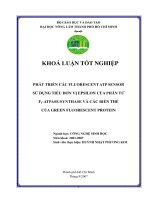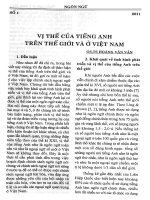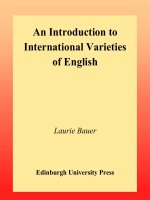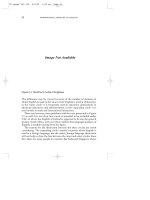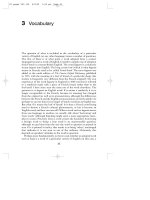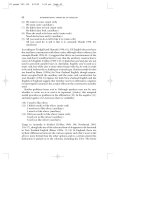Các biến thể của tiếng anh part 5 potx
Bạn đang xem bản rút gọn của tài liệu. Xem và tải ngay bản đầy đủ của tài liệu tại đây (151.38 KB, 10 trang )
3 Vocabulary
The question of what is included in the vocabulary of a particular
variety of English (or any other language) raises a number of questions.
The first of these is at what point a word adopted from a contact
language becomes a word of English. Consider a simple case of adoption
from French in current British English. The word baguette is a relatively
recent import into English. The long, crusty loaf (which is what baguette
means in French) used to be called French bread. The term baguette was
added to the ninth edition of The Concise Oxford Dictionary published
in 1995, with the meaning of a loaf of bread of a particular shape (the
texture is frequently very different from the French original!). My own
experience of the word baguette in England in 2000 was that it referred
to a sandwich made with a piece of French bread, rather than to the
loaf itself. I have since seen the same use of the word elsewhere. The
question is: is baguette an English word? If it means a sandwich, it is no
longer recognisable to the French, because its meaning has changed
from the original (as well as its pronunciation, although the differences
between the French and the English pronunciations are fairly subtle). So
perhaps we can say that it is no longer a French word, but an English one.
But what if it means the loaf of bread? Is it then a French word being
used to denote a French cultural phenomenon, or has it become an
English word, and how can one tell? When a word such as baguette moves
from one language to another, we usually talk about ‘borrowing’ and
‘loan words’ (although hijacking might seem a more appropriate meta-
phor to some). Precisely when a word crosses the boundary from being
a foreign word to being a loan word is an unanswerable question,
although we get hints from the way the word in question is printed in
text: if it is printed in italics, that marks it as being ‘other’; unchanged
font indicates it is not seen as out of the ordinary. Ultimately, this
depends on speakers’ attitudes to the word in question.
Perhaps more fundamentally, we have to ask whether an adopted word
such as koala is a word of a particular variety of English (in this case, a
32
02 pages 001-136 6/8/02 1:26 pm Page 32
word of Australian English) or whether it is simply a word of English.
Koalas are probably discussed more in Australia than they are elsewhere,
and in rather different terms (they are more likely to be discussed
because of the noise they make than because of how cuddly they look,
for example). But English only has the word koala for the animal, and
a child in Toronto is almost as likely to know the word as a child in
Melbourne. This contrasts with a word like bunyip. Although bunyips,
like koalas, figure in children’s literature, the word is much more likely
to be known in Australia than in Canada, and phrases such as the bunyip
aristocracy are likely to be met only in Australia. English only has the
word bunyip to denote bunyips, too, but the word is likely to be much
more restricted in its geographical occurrence. Is it possible to dis-
tinguish between words like koala which are English, and words like
bunyip which are Australian English? Again, it seems, not easily, and not
by any easily applicable rule. With such words, it is probably less their
existence which marks a text as Australian, than their concentration:
many mentions of koalas and bunyips (and dingoes, kangaroos, and so
on) may suggest an Australian text; an occasional mention may be found
in a text from elsewhere.
In this chapter we will go on to consider ways in which varieties of
English around the world have acquired new words, some of which (but
not all of which) will be recognised in Britain. The use of the words
marks a text as belonging to a particular variety only if the words are
concentrated in the text.
3.1 Borrowing
3.1.1 Borrowing from aboriginal languages
The most obvious source of new words for new things in the colonial
environment was clearly the language of the people who were already on
the spot. Although all sorts of myths circulate about English speakers
asking ‘What is that?’ and being told ‘I don’t know what you mean’ and
using the word for ‘I don’t know what you mean’ as the name for the new
object, there are no authenticated examples of this happening: generally
people seem to have made themselves understood well enough. In some
places the English speakers did not recognise that the aboriginal peoples
spoke a variety of different languages and might justifiably have differ-
ent words for ‘the same thing’, but that is a very different problem. Again,
it is intuitively fairly obvious that the things newcomers are likely to
ask the locals about are ‘Where are we?’ and then about the unfamiliar
phenomena surrounding them, in particular flora, fauna and the arte-
VOCABULARY 33
02 pages 001-136 6/8/02 1:26 pm Page 33
facts and practices of the aboriginals themselves. These words will be
considered as separate classes, simply because there are so many of
them, before other, more general words are looked at.
TOPONYMS
The names of new towns and recently encountered physical features
were often chosen by colonisers to remind them of Britain or of the
names of their own great people (consider Boston, Melbourne, Queenstown,
Vancouver, Wellington, and so on). But they also took over large numbers
of aboriginal names, sometimes modifying them on the way. Some exam-
ples are given in Figure 3.1.
FLORA
A few examples of borrowed names for plants are given in Figure 3.2,
along with the language they are taken from. Since the plants themselves
are not necessarily known outside their own geographical area, these
words may not all be known to you (see question 1 for this chapter), but
the general principle is well-established, that local words are used for
34 INTERNATIONAL VARIETIES OF ENGLISH
Original version Original
Name Language if different meaning
Australia
Noosa Gabi-gabi gnuthuru ghost
Toorak Woiwurung tarook black crows
Canada
Manitoba Ojibwa manitobah strait of the spirit
Quebec Abenaki quebecq where the channel
narrows
New Zealand
Otago Maori Otakou place of red ochre
Petone Maori pito-one beach end
South Africa
Bongani Xhosa give thanks
Manzimahle Zulu beautiful water
United States
Chattanooga Creek Chatanuga rock rising to a point
Ticonderoga Iroquoian Cheonderoga between lakes
Figure 3.1 Some borrowed toponyms
02 pages 001-136 6/8/02 1:26 pm Page 34
unfamiliar local plants. Not, of course, in every case: sometimes familiar
words are used for the new plants, and such cases will be discussed below.
FAUNA
Animals are treated in much the same way as plants, with the same range
of possibilities for naming them. Some borrowed words for animals are
given in Figure 3.3.
VOCABULARY 35
Original form Original meaning
Word Taken from if different if different
hickory Algonquian pocohiquara drink made from
hickory nuts
kauri Maori
mulla mulla Panyjima mulumulu
minnerichi Garuwal minariji
mobola Ndebele mbola
squash Narragansett asquutasquash uncooked green
tsamma Nama tsamas
toetoe Maori
Figure 3.2 Some borrowed words for flora
Original form Original meaning
Word Taken from if different if different
dingo Dharuk di
ŋgu
kangaroo Guugu Yimidhirr ga
ŋurru male grey kangaroo
kookaburra Wiradhuri gugbarra
masonja Shona masondya
moose Abenaki mos
raccoon Algonquian oroughcun
skunk Algonquian sega¯kw
tsetse SeTswana tsètsè
tuatara Maori
tui Maori
Figure 3.3 Some borrowed words for animals
02 pages 001-136 6/8/02 1:26 pm Page 35
CULTURAL ARTEFACTS AND PRACTICES OF THE ABORIGINAL
PEOPLES
Just as unknown as the flora and fauna that are met in the colonial
situation are the cultural practices of the local peoples and the physical
objects used in them. Sometimes a local custom has an obvious equiv-
alent word, for example a funeral. Occasionally, the local custom seems
so foreign that such an equivalent does not seem justified, as with powwow
(listed in Figure 3.4) or the Maori equivalent hui.
OTHER MORE GENERAL WORDS
Although there are obvious reasons for borrowing words for unfamiliar
objects and practices, speakers also borrow words for more familiar
things. Sometimes this is done because of the perceived foreignness of
the object, sometimes it is done because the borrowed word appears
particularly useful or suitable (sometimes for reasons which cannot
easily be reconstructed). Some examples are given in Figure 3.5.
3.1.2 Borrowing from other types of English
The assumption here has been that speakers of standard British English
36 INTERNATIONAL VARIETIES OF ENGLISH
Original form
Word Meaning Taken from if different
boomerang Dharuk bumarin
y
bora initiation Kamilaroi buuru
ceremony
mere club Maori
muti African medicine Zulu umuthi
mungo bark canoe Ngiyambaa ma
ŋgar
pa fortified village Maori
potlatch ceremonial giving Nuu-chah-nulth patlatsh
away of property
powwow meeting, Algonquian powwaw
gathering
sangoma witch doctor Zulu isangoma
teepee conical tent Sioux tı¯pı¯
tokoloshe evil spirit Zulu utokoloshe
Figure 3.4 Some borrowed words for artefacts and cultural practices
02 pages 001-136 6/8/02 1:26 pm Page 36
brought with them to the various colonies the words of standard British
English, and enlarged upon that word-stock by borrowing from local
languages. But of course that is a simplification. Not only did emigrants
from many different regions settle in the new colonies, bringing with
them their own non-standard words, there has been continual contact
since settlement with the rest of the English-speaking world. For this
reason a word that is only dialectal in Britain may nevertheless be
standard (or at least widespread) in another national variety, and words
which originated outside Britain may have become standard (or wide-
spread) outside their home area (and sometimes in Britain, too). Some
examples are given in Figure 3.6. A special case here is the large number
of Americanisms, often overtly despised outside North America, but
adopted anyway, which have spread not only to Britain but to the rest
of the world. Some examples are: disc-jockey, gangster, gobbledygook, hot-dog,
itemize, joy-ride, mail-order, porterhouse steak, sky-scraper, trainee, usherette,
vaseline. The examples have been chosen to show how unremarkable
VOCABULARY 37
Original form and/or
Country Word Meaning Taken from meaning if different
Aus billabong blind creek Wiradhuri river which runs
only after rain
Aus budgeree good Dharuk bujari
Aus cooee call attracting Dharuk guwi
attention
CDN hyak hurry up!, Chinook
immediately Jargon
CDN iktas goods, Chinook
belongings Jargon
NZ kia ora a greeting Maori
Aus koori Aboriginal man Awabakel guri: man
CDN loshe good Chinook
Jargon
SA mbamba illicitly brewed Zulu bamba: strike with
liquor a stick
US mugwump a great man Algonquian mugquomp:
great chief
NZ puckeroo broken Maori pakaru
Figure 3.5 Some examples of other borrowed words
02 pages 001-136 6/8/02 1:26 pm Page 37
such innovations seem after several years of constant use. (For further
discussion see section 7.1.)
3.1.3 Borrowing from other colonial languages
In Canada, English speakers met French speakers who were already
colonising the region; in the United States English speakers met French
speakers near the Canadian border and in Louisiana, and Spanish
speakers in New Mexico, Texas and California; in South Africa they met
Dutch speakers. These contacts also left their traces. Sometimes place-
names are those given by other colonisers (Bloemfontein, Detroit, Los
Angeles, Montreal, and so on). Sometimes English has adopted words for
colonial phenomena from another colonial language: meerkat, melkboom,
moegoe (/
mυxυ/‘country bumpkin’, possibly from Bantu) are all taken
into South African English from Cape Dutch/Afrikaans. Sometimes
words from aboriginal languages passed through one of these other
colonial languages before being borrowed into English. Again, words for
flora and fauna are numerous in this process. Examples are given in
Figure 3.7. Sometimes words were simply taken over from the other
colonising language and applied to local phenomena: armadillo, bonanza,
canyon, coyote, palomino, lasso, sarsaparilla, sierra, yucca are all from Spanish;
ratel, spoor are from Dutch/Afrikaans; mush! (a command to sled dogs) and
gopher (‘ground squirrel’) are both from French.
3.1.4 Borrowing from external languages
English is well known as being a language which is very open to bor-
rowing, and this overall tendency remains just as important in colonial
38 INTERNATIONAL VARIETIES OF ENGLISH
Country Word Original variety Meaning
Aus attle Cornish refuse from a mine
Aus, NZ dinkum Lincolnshire work, thence true,
genuine
SA stroller Scottish street kid
Aus, NZ stroller US pushchair
Aus wild cat (mine) US a mine in land not
known to be productive
Aus, NZ youse Irish you (pl)
Figure 3.6 Words borrowed from external varieties of English
02 pages 001-136 6/8/02 1:26 pm Page 38
Englishes. It is thus not unusual for just one variety of English to borrow
from an external language (neither a local aboriginal language, nor a
contact colonising language), and for that loan word to be a potential
marker of the appropriate variety. Some examples are given in Figure
3.8.
VOCABULARY 39
Original Aboriginal Original meaning
Word language if different
Via French
bayou Choctaw stream
caribou Mi’kmaq snow-shoveller
Eskimo Algonquian eaters of raw flesh
pichou Cree
toboggan Mi’kmaq
Via Cape Dutch
quagga Khoikhoi
Via Spanish
sassafras origin unknown
Figure 3.7 Aboriginal terms borrowed into English via other colonial
languages
Word Used in Origin
bandicoot SA Telugu pandikokku
depot (‘railway station’) US French
dime NAm French
echidna Aus Greek, meaning ‘viper’
(because of the shape of
the animal’s tongue)
malish (‘never mind’) Aus Egyptian Arabic
padrao (‘inscribed pillar’) SA Portuguese
panga (‘cane-cutter’s knife’) SA Swahili
sashay NAm French chassé
Figure 3.8 External borrowings
02 pages 001-136 6/8/02 1:26 pm Page 39
3.2 Coining
As well as borrowing new vocabulary from other languages, languages
all have the ability to generate their own new words and expressions by
a number of different means. These are the focus of this section.
3.2.1 Calques: coining on the basis of another language
Calques are also called ‘loan translations’, and are a kind of half-way
house between borrowing and coining. Rather than borrowing a foreign
word or expression as is, each part of that expression is translated into
English to form a new English expression. South African English seems
to have particularly open to this method of gaining new words. Some
examples are given in Figure 3.9.
3.2.2 Compounds
By far the most common way of creating new words from the resources
of English is by compounding: putting two words together to form a new
word. A number of examples from different varieties of English around
the world are given in Figure 3.10.
40 INTERNATIONAL VARIETIES OF ENGLISH
Word/expression Translated from Meaning
land of the long white Maori Aotearoa New Zealand
cloud
dreamtime Aranda alcheringa mythical era when the
world was formed
marsh rose Afrikaans vleiroos
on one’s nerves Afrikaans op sy senuwees tense and likely to get
angry
now now Afrikaans nou nou a moment ago
stay well Xhosa, Zulu, etc. farewell
stockfish Dutch stokvis hake
treesnake Dutch boomslang (also used)
monkey’s wedding Portuguese simultaneous rain and
shine
mat house Afrikaans matjieshuis
Figure 3.9 Calques
02 pages 001-136 6/8/02 1:26 pm Page 40
3.2.3 Derivatives
Although compounding is the most common way of forming new words
to describe the new situations met by colonists, derivation is also used,
perhaps especially in the USA. From Australia we find derivatives such
as arvo, barbie, bathers, watersider ; from Canada words like hauler; from
New Zealand words such as gummy, scratchie, sharemilker and ropable
(which is also used in Australia); from South Africa comes outie; and
accessorize, beautician, burglarize, hospitalize, mortician, realtor, winterize are
all from the USA.
3.2.4 Other word-formation processes
There are a number of processes besides compounding and derivation
which can be used to form new words, and these processes can give rise
to words which are identified with one particular variety of English.
Clipping gives us gas, gym, movie, narc, stereo (all originally from the USA);
blending gives us motel and stagflation (both originally from the USA);
back-formation gives us commute, electrocute (both originally from the
USA). Clipping with suffixation gives us New Zealand English pluty
‘posh’. And imitation gives us Australian mopoke ‘species of owl’. Every
country has its own sets of initialisms and acronyms referring to local
institutions.
3.2.5 Changes of meaning
As well as the creation of new forms, vocabulary expansion can take
place by giving new meanings to old forms. Again, these new meanings
VOCABULARY 41
bellbird (Aus, NZ) monkey orange (SA) rhinoceros bird (SA)
bloodwood (Aus) mousebird (SA) soap opera (US)
boxcar (NAm) murder house (NZ) soapbush (SA)
cabbage tree (Aus, NZ, SA) paper bark (Aus, NAm) soda fountain (NAm)
catbird (NAm) parrot fish (SA) stickfight (SA)
copperhead (Aus, NAm) rattlesnake (NAm) wetback (US)
frost boil (CDN) rest camp (for visitors at
glare ice (CDN) a game reserve) (SA)
Figure 3.10 Examples of compounds formed in varieties of English from
around the world
02 pages 001-136 6/8/02 1:26 pm Page 41
